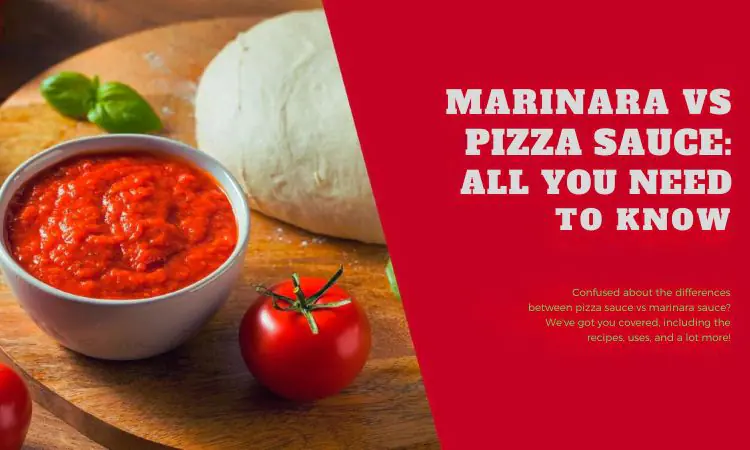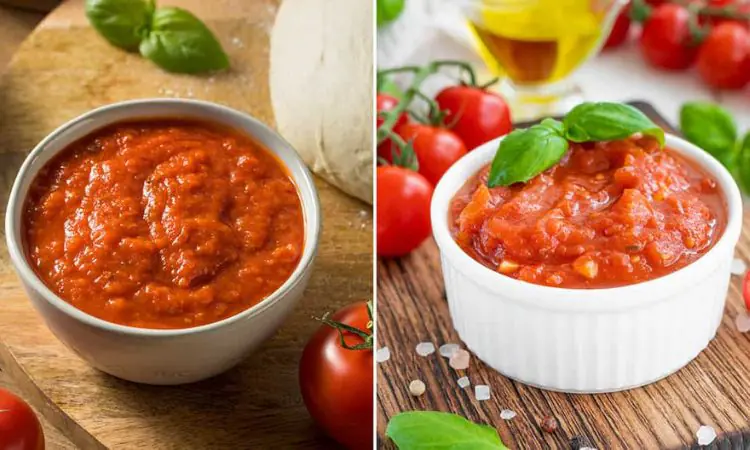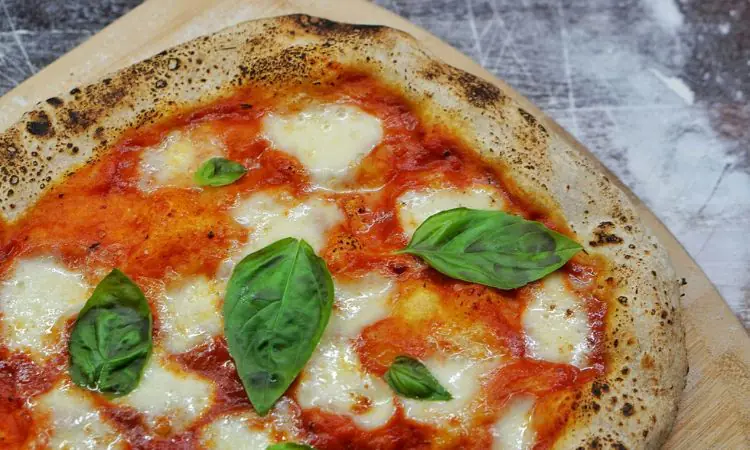Pizza sauce is typically thicker and more complexly seasoned than marinara. Marinara is a quicker-cooked sauce that’s usually thinner with a lighter flavor.
Pizza sauce and marinara are two critical components in Italian cuisine, often mistaken for one another due to their similar tomato base. The primary difference lies in their texture, ingredient complexity, and preparation. Pizza sauce, meant to spread evenly over pizza dough, offers a rich blend of tomatoes and a more robust selection of herbs and spices.
Contrastingly, marinara, commonly served with pasta or used as a dipping sauce, is characterized by its lighter consistency and fresher taste, generally featuring fewer herbs and a more straightforward flavor profile. Understanding these distinctions helps cooks choose the proper sauce for creating authentic dishes. SEO-friendly content about the difference between pizza sauce and marinara not only clarifies cooking techniques but also aids in refining culinary choices for chefs and food enthusiasts alike.

The Essence Of Pizza Sauce
The true character of a perfect slice of pizza starts with its foundation – the essence of pizza sauce. This specially crafted sauce isn’t just any tomato-based topping. It’s a unique blend tailored to complement the dough, cheese, and toppings of a classic pizza.
Texture Trademarks
The secret to a memorable pizza lies in the texture of its sauce. Unlike marinara, pizza sauce boasts a thicker consistency. This robust texture ensures it doesn’t soak through pizza dough, keeping the base crisp and satisfyingly chewy.
The Spice Spectrum
Herbs and spices are the lifeline of any great sauce. Pizza sauce tends to exhibit a more straightforward spice profile with basics like oregano, basil, and garlic. The aim is a flavor that merges seamlessly with a wide array of toppings, letting the sauce enhance but not overpower the taste of the pizza.
Marinara Sauce Uncovered
Dive into the vibrant world of marinara sauce, a staple in Italian cuisine. This versatile sauce brings life to numerous dishes. Understanding what sets marinara apart from pizza sauce paints a clearer picture of its unique traits.
Origins And Herbs
Marinara sauce boasts a rich heritage, with roots tracing back to Italy. Simple and flavorful, the sauce initially fed sailors on long journeys, hence ‘marinara’ from ‘mariner’s.’ Key ingredients are tomatoes, garlic, onions, and a signature blend of Italian herbs.
- Tomatoes: The heart of the sauce.
- Garlic and onions: Sautéed to perfection.
- Italian herbs: Basil and oregano are most common.
Consistency And Uses
Marinara sauce is notable for its fluidity. It’s a bit thinner than pizza sauce. Uncooked tomatoes create a lighter texture. This consistency makes it perfect for various uses. Marinara is ideal for:
| Dish Type | Use of Marinara |
| Pasta | Tossing with spaghetti or layering in lasagna. |
| Dipping | Serving with mozzarella sticks or breadsticks. |
| Seafood | Accompanying shrimp or calamari. |
Ingredient Breakdown
Exploring the world of sauces, we often stumble upon pizza sauce and marinara. They may look similar, but their ingredient list tells another story. In this ‘Ingredient Breakdown,’ we’ll dive deep into what sets these two famous sauces apart, starting from their base ingredient to the variety of flavor enhancers that culminate in their distinct profiles.
Tomato Talk
The foundation of both sauces is, in essence, tomatoes. But, the type and treatment of tomatoes distinguish a pizza sauce from its cousin, marinara. Let’s outline their differences:
- Pizza Sauce: Often uses uncooked pureed tomatoes.
- Marinara: Primarily involves cooked tomatoes, creating a different texture and flavor.
Flavor Enhancers
Delving into the realm of herbs and spices, each sauce embraces a unique selection to enhance its taste:
| Ingredient | Pizza Sauce | Marinara |
| Garlic | Less prominent | Heavily featured |
| Onions | Rarely used | Commonly included |
| Herbs | Dried oregano, basil | Fresh parsley, basil |
| Salt | Just a pinch | Seasoned to taste |
In pizza sauce, the flavor profile is kept simple with a focus on a more pungent tomato taste, making it the perfect backdrop for a variety of pizza toppings. Marinara, meanwhile, showcases a more complex taste with a medley of fresh herbs and a more profound garlic influence.
Cooking Methods Compared
Cooking Methods Compared: Understanding the process behind your favorite sauces is essential. Both pizza sauce and marinara come with distinct cooking techniques that alter their flavor, texture and uses. Let’s delve into the simmering and raw preparation methods that set these two famous Italian sauces apart.
Simmering Secrets
Pizza sauce often involves a simmering process. This method includes cooking the tomatoes and blending them with herbs and spices overheat. This slow-cooking method allows the flavors to meld together, creating a thick, rich sauce.
Key points about simmered pizza sauce:
- It is cooked for a longer time to enhance flavor.
- Smoothened texture perfect for spreading on pizza dough.
- It is commonly made with tomato paste for a concentrated taste.
Raw Revelations
In contrast, marinara sauce is often created from raw ingredients. These are blended without the application of heat, preserving a fresh tomato flavor. This quick and uncooked method leads to a more vibrant, tangier sauce.
Characteristics of raw marinara:
- Its bright, fresh tomato flavor distinguishes it.
- It is mainly used as a dipping sauce or pasta topping.
- Contains chunkier tomato pieces for texture.
Cultural Contexts
Cultural Contexts delve into the traditions and evolutions of cuisine. Italian food, rich in history and flavor, offers two famous sauces: pizza sauce and marinara. Originating from different culinary backgrounds, they hold unique places in Italian cooking and beyond.
Italian Traditions
In Italy, pizza sauce and marinara originate from distinct regional recipes. Pizza sauce, often uncooked, adorns traditional pizzas with its thick, rich consistency. Marinara sauce, on the other hand, hails from the coastal regions as a quick sauce used for pasta and seafood.
The table below illustrates the key ingredients typically found in each sauce:
| Pizza Sauce Ingredients | Marinara Sauce Ingredients |
| Tomato paste | Crushed tomatoes |
| Garlic | Garlic |
| Olive oil | Olive oil |
| Seasoning herbs | Fresh basil |
Families and chefs across Italy have passed down these authentic recipes for generations. Each sauce represents Italy’s culinary heart and soul.
Modern Adaptations
The global love for Italian cuisine has led to modern twists on classic sauces. Pizza sauce now embraces various spices and cooking techniques, while marinara is a go-to quick sauce not only for pasta but also as a dipping sauce.
- Pizza Sauce: Thicker, spread on dough before baking
- Marinara: Lighter, versatile, used in many dishes
In modern kitchens, cooks often experiment with these sauces, adding ingredients like chili flakes or smoked paprika to create unique flavors. These adaptations reflect contemporary trends and the fusion of global culinary practices.

Nutritional Nuances
Understanding the nutritional differences between pizza sauce and marinara is vital for healthy eating. Although they both come from tomatoes, their ingredients and preparation can affect their nutritional value. Let’s dive into the specifics, looking at the caloric content and health benefits of each sauce type.
Caloric Content
Dish choices can impact your daily calorie intake significantly. The sauces that dress your pasta or pizza are no exception. Pizza sauce is often denser in calories because it may contain more olive oil and cheese. In contrast, marinara sauce tends to be lighter, with fewer calories, as it is generally a more straightforward mix of tomatoes and spices.
| Sauce Type | Calories Per Serving |
| Pizza Sauce | ~80-90 calories |
| Marinara Sauce | ~70-80 calories |
Health Benefits Breakdown
Not all sauces are created equal from a health perspective. Loaded with tomatoes, both sauces provide vitamin C, potassium, and lycopene. However, marinara’s more straightforward recipe often means less added sugar and fat, making it a potentially healthier choice. Let’s outline some key benefits.
- Lycopene: An antioxidant found in tomatoes that supports heart health.
- Vitamin C: Boosts the immune system and heals the body.
- Potassium: Regulates blood pressure and heart function.
Remember, choosing between pizza sauce and marinara shouldn’t just be about taste but also how they can positively influence your overall well-being. Read labels carefully, noting sugar and fat content, to make the choice that aligns with your health goals.
Versatility In The Kitchen
Pizza sauce and marinara are critical players in Italian cuisine. They may seem similar, yet their versatility sets them apart. Whip up diverse dishes by understanding these two.
Pairing Possibilities
Pizza sauce tastes excellent on dough, adding zesty flavor to pies. Marinara, with more liquid, suits pastas and dippings well.
- Topping for bruschetta: Marinara shines here.
- Filling for lasagna: Both sauces can work, but marinara’s texture wins.
- The base for meatball subs: Go with a hearty marinara.
- Topping for mozzarella sticks: Marinara is the perfect dip.
Recipe Reinventions
Both sauces can inspire new dishes. Transform your kitchen into a creative studio with these sauces’ adaptability.
| Sauce | Recipe Ideas |
| Pizza Sauce | Stuffed bell peppers Pizza bagels Savory pizza cupcakes |
| Marinara Sauce | Spaghetti Squash Marinara Eggplant Parmesan Minestrone base |
Making Your Own
Many pizza lovers and culinary explorers alike find joy in crafting their sauces. Whether it’s the bold taste of pizza sauce or the versatile tang of marinara, creating these flavors at home offers a tailored experience to any dish. Notably, the freshest ingredients can elevate your homemade sauce to rival any store-bought version. Let’s dive into how you can make your pizza sauce and marinara and discover the nuances of each that set them apart.
Dyi Pizza Sauce
Pizza sauce is a cornerstone of the perfect homemade pizza. Its thick consistency and rich flavor infuse the dough with a hearty base. Here’s an easy recipe:
- Combine 1 can of crushed tomatoes with 1 teaspoon of salt.
- Mix in 1 teaspoon of sugar, 2 cloves of minced garlic, and 1 teaspoon of olive oil.
- Add herbs like oregano, basil, and a pinch of red pepper flakes to taste.
- Cook over low heat for 10 minutes, stirring occasionally.
- Let the sauce cool before spreading on your pizza dough.
The key to DIY pizza sauce is simplicity and a smooth, spreadable texture.
Homemade Marinara Magic
Marinara sauce, with its light texture and fresh taste, serves as a versatile condiment. It complements pasta, seafood, and many other dishes. Follow these steps for a tasty marinara:
- Begin with a base of finely chopped onions and garlic in olive oil.
- Add canned whole tomatoes, crushing them by hand for texture.
- Season with a bay leaf, basil, salt, and a splash of red wine vinegar.
- Simmer for 20 minutes until the sauce thickens slightly.
- Finish with a handful of fresh basil, and adjust the seasoning if needed.
Marinara sauce shines through its chunky consistency and aromatic herbs.

Frequently Asked Questions Of What Is The Difference Between Pizza Sauce And Marinara
Can I Substitute Marinara Sauce For Pizza Sauce?
Yes, you can substitute marinara sauce for pizza sauce. The difference in herbs and texture slightly alters the flavor.
Does Marinara Sauce Taste The Same As Pizza Sauce?
No, marinara sauce and pizza sauce have distinctive tastes. Marinara is usually more garlic and herb-based, whereas pizza sauce has a more straightforward, concentrated tomato flavor.
Can You Use Pizza Sauce For Spaghetti?
Yes, you can use pizza sauce for spaghetti. It may have a slightly different herb blend, but it works well for a quick meal.
Is Domino Marinara Sauce The Same As Pizza Sauce?
Domino’s marinara sauce differs from their pizza sauce in flavor profile and usage. The marinara is a dipping sauce, while the pizza sauce goes on pizzas.
Conclusion
Understanding the nuances between pizza sauce and marinara can elevate your cooking game. Each brings its unique flair to dishes, and choosing the right one can make all the difference. Whether you’re crafting a homemade pizza or simmering a pasta dish, remember—pizza sauce is for spreading, and marinara is for dipping and draping.
Discover, experiment, and enjoy the diverse world of Italian sauces in your culinary adventures.

As the author of the “Ultimate Pizza Guide: Recipes, Tips & Secrets Revealed,” I’m dedicated to sharing my love for pizza and empowering others to create delicious homemade pizzas with ease. Join me on a journey to uncover the secrets to perfecting your pizza game!


